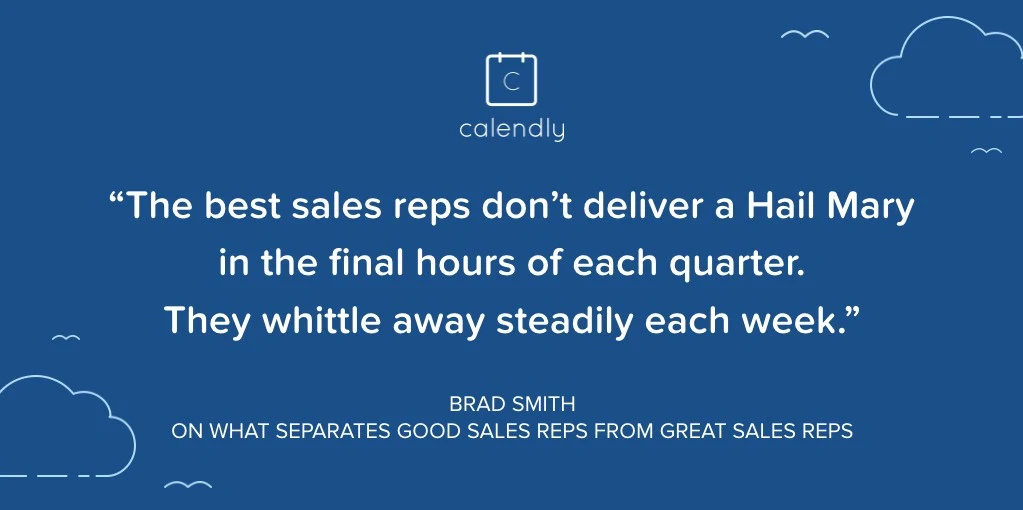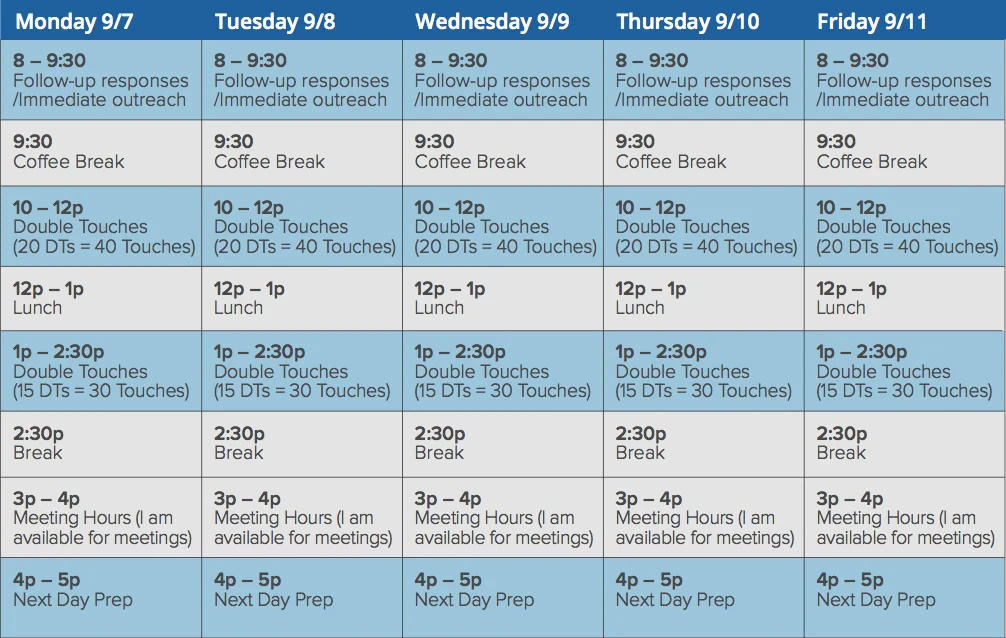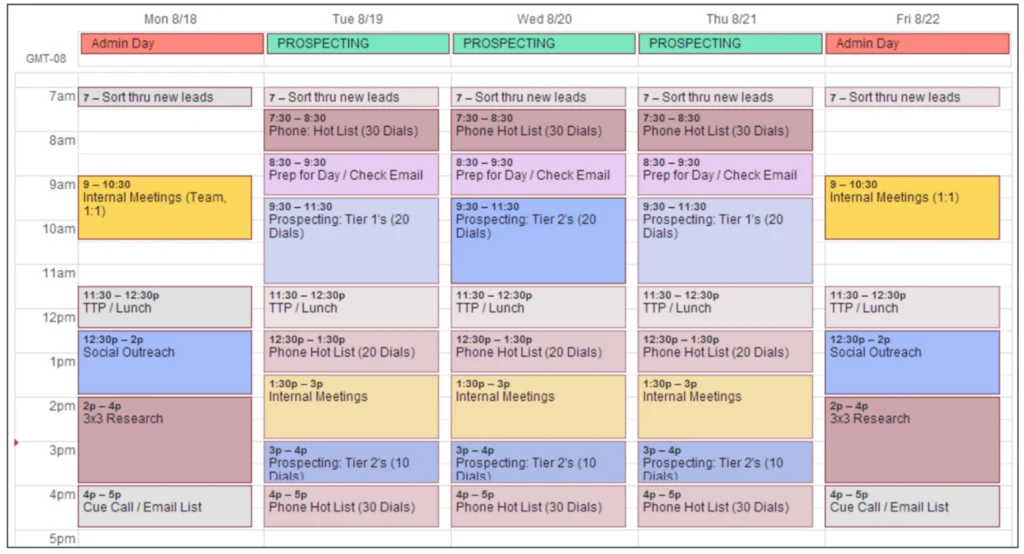Timeboxing: double your sales reps' output with this calendar strategy
This calendar trick helps sales reps knock out top priorities before roadblocks derail momentum.
Table of contents
Your reps have been "at it" for hours.
Cranking away. Batching and blasting, replying and dialing.
With little-to-nothing to show for "it."
What’s blocking salespeople from hitting quotas?
Ralph Barsi wrote a series about the barriers blocking salespeople from hitting quotas.
The key factors, he writes, include:
Obscurity
Lack of Focus
Inactivity
No Conversation Flow
Failure to Continue Learning
The first thing to notice is that these blockers are a product of circumstances. Here’s what that means for you:
The first way to empower your reps — well before polishing their closing techniques — is to give them the right environment.
Namely, an environment that’s set up to help them succeed in the first place: one that gives them a little direction and context to knock out the big obstacles first, so roadblocks don’t derail their momentum.
The difference between salespeople at the top and everyone else is a maniacal focus on how their days are spent.
That single-minded focus creates room for “deep work," as Cal Newport calls it.
Newport is a computer science professor at Georgetown, MIT postdoc, and author of several bestselling books in addition to running popular blog, Study Hacks .
“One of the keys to focusing on “deep work” work (as opposed to “shallow work” — aka, all the low-value junk that commonly gets in the way), is timeboxing.”
Cal Newport
Author of "Deep Work" and Associate Professor of Computer Science at Georgetown University
Here’s how it works, and how your reps apply the same lessons to their own calendars:
Fixed-schedule productivity: How ‘timeboxing’ can create space for the most productive work
Timeboxing creates a fixed schedule.
It forces reps to allocate specific time periods (like a box) to specific activities on their calendars. These are the move the needle-type activities: the stuff they know they should be doing more of (but for whatever reason, aren’t).
By specifically allocating blocks of time throughout the week though, you’re ensuring that these commitments are kept as appointments. Everything else that pops up — like random leads and time-wasting emails back and forth to schedule meetings and Slack notifications — either have to work around these pre-set appointments with yourself, or they simply fall by the wayside.
The sales-producing activities, then, like sales calls or biz dev, get put on the calendar. The other junk takes a back seat, or gets automated with tools like Calendly to keep reps focused on what matters.
And this happens on a daily basis.
If a single SQL is due each day, they apply their historical conversion rate, come up with the number of leads and MQLs to work through, eventually backing out to the number of phone calls or email follow ups required.
Point is, they’re using leading indicators as measures of activities — e.g., inputs, like phone calls or email follow ups — as predictors of success. Instead of relying on un-actionable, already-too-late lagging ones.
Now, they can use a visual scorecard to create accountability (Seinfeld’s infamous “don’t break the chain” productivity tip) and understand what should be expected each day.
Once your reps are doing that, it’s time to break out the calendar.
After the discovery call: The AE playbook for driving deals from demo to close
How reps can take back control of their schedules once and for all
With daily activities and goals come clarity: you’ve got a handful of priorities that need to get done this week. And the only way that’s gonna happen is if you actually prioritize those priorities.
The simplest approach is to literally take a weekly calendar with days split out, like Google's or Apple’s or even a simple spreadsheet, and carve out a few hours for your most important tasks.
This example comes courtesy of TOPO:
Here are the main ingredients:
Reps should start the day with early phone calls to tough-to-reach peeps, along with banging out important follow-ups.
A few breaks are scheduled throughout the day, so they can take a breather and mentally refresh, before diving head-first into…
Cranking through those major touches. ‘Batching’ techniques, with no other distractions, can help them blow through these in just a few hours, prior to any... Meetings
Finally, instead of heading straight to happy hour, there’s a final block spent on preparing everything for tomorrow. The best tip, WAY beyond this post’s scope, is to apply mise en place.
Another approach that Barsi recommends is the “bookends approach.” In this case, you’re not treating every single day the same, but using Mondays and Fridays for preparation, research, and all that other stuff that needs to get done throughout the week.
When done correctly, that should free up Tuesdays, Wednesdays, and Thursdays to hit it hard.
Now, there’s structure. You’ve got themes and a pretty calendar with vibrant colors like a tapestry.
But way more importantly, you’ve got appointments. Accountability. Notifications on your phone that pop up, alerting you to the next block starting in 10 minutes, so you’d best wrap up that ping pong game ASAP.
Now get started
The "formula" should be set. Spend X time, devoted to Y activities, and a rep should wind up with Z this quarter.
Time boxing the calendar simplifies. But it also enhances production, carving out time for “deep work” that requires intense focus and effort channeled behind a single activity.
Once you’ve got the space and the rhythm, you can worry about leveraging this time. About cutting back time wasted scheduling appointments to make more phone calls per hour, or sending more emails through templates.
But it starts with the basics. On a daily basis.
Guide: 8 Expert Tips to Simplify the Most Complicated B2B Sales Meetings
Related Articles
Don't leave your prospects, customers, and candidates waiting
Calendly eliminates the scheduling back and forth and helps you hit goals faster. Get started in seconds.



